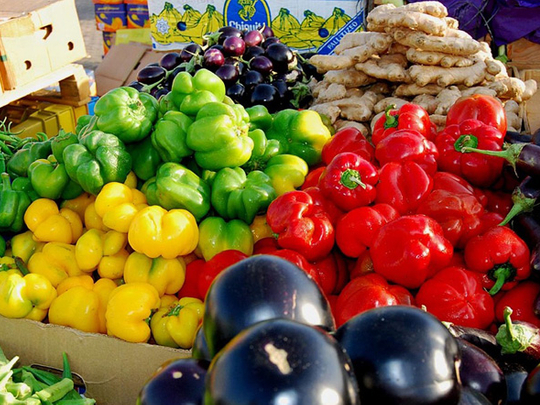
Dubai: The prices of fruit and vegetables that soared in the Gulf region and the rest of the Middle East during the summer are expected to remain at their current high levels due to the unusually cold winter.
The price rise, however, could slow down or even halt in the foreseeable future.
But a return to the price levels of previous seasons is ruled out given a string of factors that include excessive usage of pesticides and adverse weather, experts and traders say.
"The current unprecedented high prices will fall in the next few months, in particular when favourable weather returns and supply increases in response to the extremely high prices," said Shangnan Shui, a commodity specialist at the Rome-based UN Food and Agriculture Organisation.
"However, we may not expect that the prices will fall to the low level we experienced in the past. If all other agricultural commodity prices remain at a relatively high level, vegetable prices should match the price level of other substitutable crops," Shui explained in a statement to Gulf News.
Oil price impact
"Moreover, the higher oil price will push production costs higher, which induces higher vegetable prices," added the UN expert.
Consumers have been complaining that prices of fruit and vegetables have become comparable to those of meat, poultry and fish if not higher during the past few months.
For example, tomatoes have begun to be called by the public in some areas in the Gulf as "the queen of the table" with their soaring prices across the region. They became hard to find even in markets of countries of origin during the summer and the current trend is not much different.
Several weeks ago, a public campaign was organised in Kuwait under the slogan ‘Let it rot' which aimed to launch a boycott of high-priced vegetables including tomatoes.
While droughts and floods have affected agricultural production in the past few months in China and Thailand, a cabbage price crisis erupted in South Korea several weeks ago.
Vegetable prices also soared in India in the summer because of the heat wave, experts noted.
Recently, the Indian government banned exports of onions after their price in Indian cities more than doubled in two weeks as a result of a domestic shortfall due to unusually heavy rain. Pomegranate prices shot up during the summer in some Middle Eastern countries that are major growers of certain fruits and vegetables, like Jordan.
Prices of citrus fruits have also been on the higher side this winter than in previous seasons and they are not as juicy as they usually are because of the dry weather.
Among the long list of examples of "explosive" prices of vegetables across the region as a result of unusual weather is the price of lettuce.
In previous seasons the price of lettuce in some countries would hover around $1.40 (Dh5.14) for five head.
At present, the same amount of money can buy just one head in Jordan.
Problems in origin or exporting countries are echoed in importing nations such as the UAE, where many vegetable prices shot up, forcing giant groceries and hypermarkets to find other alternatives to fill the gap in supply, traders say.
New sourcing plans
"We are trying to meet the short supply by establishing new sourcing centres in different countries and this has helped us to an extent to keep the supply and prices steady in comparison to other competitors," said Ashraf Ali M.A., Executive Director of the Lulu hypermarket chain.
"Now we have direct contracts with producers and farmers' societies in many countries which help us to avoid middlemen and keep our prices low," he explained to Gulf News.
"We have started stocking enhanced varieties of locally grown vegetables in our stores.
"This helps the UAE farmers to produce better quality and at the same time helps us keep the supply steady," he said.
At the same time, "margins on vegetables and fruit have come down drastically and in many cases we are selling at cost price," he added.
Prices of certain greens and fruit were on a roller-coaster ride for the past few months, not just because of the unsuitable weather, but also because of the "heavy use of pesticides" in the countries of origin, some press reports noted.
The banning of imports of some kinds of vegetables has raised those prices by 50 per cent, the Arabic media reports noted.
The current cold wave in Europe has been another contributing factor affecting imports and exports of certain fruit and vegetables, traders pointed out.
"Now with the onslaught of winter many European flights have been disrupted and this has also affected the supply of agricultural produce from those countries.
The severe summer and floods in many countries are the main reasons for poor harvests this year," Ali noted.
However, prices of several items have started to fall in some markets although they are generally still higher than in previous years, according to consumers.
Gradual reduction
For instance, buyers said, a few weeks ago the price of one kilo of Omani zucchini in UAE groceries hovered around Dh12. At present, it is below the ceiling of Dh5 per kilo.
While the price of a kilo of potatoes hit Dh14, the price of one kilo of potatoes imported from Saudi Arabia is around Dh4.
A combination of factors led to low vegetables harvests and the resultant shortage of supply led to higher prices, but experts say there are other factors that should be taken into consideration.
These include higher oil prices in winter which raise the cost of transportation and seasonal higher demand during the holidays, as well as "the sharp increase in money supply in many countries in the world to combat the world financial crisis since 2008 may also contribute to the price surge — inflation expectations," Shui said.
Do you think the authoritiesshould establish a buffer stock tocounter rising prices? Should the UAE look at granting subsidies toresidents growing their own fruits and vegetables?














